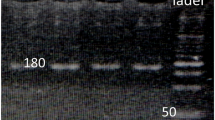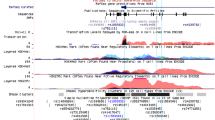Abstract
Human Immunodeficiency Virus (HIV-1) infections are characterized by dysfunctional cellular and humoral antiviral immune responses. The progressive loss of effector functions in chronic viral infection has been associated with the up-regulation of programmed death-1 (PD-1), a negative regulator of activated T cells and Natural Killer cells. In HIV-1 infection, increased levels of PD-1 expression correlate with CD8 + T-cell exhaustion. In vitro, PD-1 blockade using PD-1 antibodies led to an increase in HIV-1 specific CD8 + T and memory B cell proliferation. We aimed to investigate the impact of PDCD1 rs10204525 polymorphism on HIV-1 susceptibility, AIDS development, and treatment response outcomes in HIV-1 infection in a Moroccan population. A total of 214 HIV-1 seropositive and 250 seronegative subjects were enrolled to investigate the association between the between the single-nucleotide polymorphism (SNP) rs10204525 of PDCD1 gene and HIV-1 pathogenesis using a predesigned TaqMan SNP genotyping assay. No significant association was found between rs10204525 and susceptibility to HIV-1 infection and AIDS development (p > 0.05). Genotype frequencies were significantly associated with the viral load before ART (p = 0.0105). HIV-1 viral load was significantly higher among subjects with the CC compared to TT genotype (p = 0.0043). In treated subjects, the median of viral load levels was significantly higher in CC and CT groups than TT subjects (p < 0.005). However, analysis of the correlation between CD4 + T-cell levels and PDCD1 polymorphism before and after ART showed no significant difference (p > 0.05). Our results demonstrated that rs10204525 polymorphism does not affect HIV-1 infection. However, this polymorphism may affect the response to treatment as measured by RNA viral load levels.


Similar content being viewed by others
References
Global HIV and AIDS statistics — 2020 fact sheet [Internet]. https://www.unaids.org/en/resources/fact-sheet. (Accessed 2020 Jul 8)
Maroc | ONUSIDA [Internet]. https://www.unaids.org/fr/regionscountries/countries/morocco. (Accsessed 2020 May 8)
Klenerman P, Hill A (2005) T cells and viral persistence: lessons from diverse infections. Nat Immunol 6(9):873–879
Wherry EJ, Ahmed R (2004) Memory CD8 T-cell differentiation during viral infection. J Virol 78(11):5535–5545
Migueles SA, Laborico AC, Shupert WL, Sabbaghian MS, Rabin R, Hallahan CW et al (2002) HIV-specific CD8+ T cell proliferation is coupled to perforin expression and is maintained in nonprogressors. Nat Immunol 3(11):1061–1068
Zhang D, Shankar P, Xu Z, Harnisch B, Chen G, Lange C et al (2003) Most antiviral CD8 T cells during chronic viral infection do not express high levels of perforin and are not directly cytotoxic. Blood 101(1):226–235
Copeland NG and KFT (2003) CD8+ T-Cells: function and response to HIV infection [Internet]. current HIV research. http://www.eurekaselect.com/91464/article. (Accessed 2018 Feb 1)
Koszinowski UH, Reddehase MJ, Jonjic S (1991) The role of CD4 and CD8 T cells in viral infections. Curr Opin Immunol 3(4):471–475
Demers KR, Reuter MA, Betts MR (2013) CD8+ T-cell effector function and transcriptional regulation during HIV pathogenesis. Immunol Rev 254(1):190–206
Lee A, Park SP, Park CH, Kang BH, Park SH, Ha S-J et al (2015) IL-4 induced innate CD8+ T cells control persistent viral infection. PLoS Pathog 11(10):e1005193
Stipp SR, Iniguez A, Wan F, Wodarz D (2016) Timing of CD8 T cell effector responses in viral infections. Royal Soc Open Sci 3(2):150661
Gulzar N, Copeland KFT (2004) CD8+ T-cells: function and response to HIV infection. Curr HIV Res 2(1):23–37
Alcami A, Ghazal P, Yewdell JW (2002) Viruses in control of the immune system. EMBO Rep 3(10):927–932
Insights into how HIV evades immune system [Internet]. National institutes of health (NIH). 2015 https://www.nih.gov/news-events/nih-research-matters/insights-into-how-hiv-evades-immune-system. (Accessed 2018 Jan 15)
Nowak MA, McMichael AJ (1995) How HIV defeats the immune system. Sci Am 273(2):58–65
Garba ML, Pilcher CD, Bingham AL, Eron J, Frelinger JA (2002) HIV antigens can induce TGF-β1-producing immunoregulatory CD8+ T cells. J Immunol 168(5):2247–2254
Charles A Janeway J, Travers P, Walport M, Shlomchik MJ (2001) Infectious agents and how they cause disease. https://www.ncbi.nlm.nih.gov/books/NBK27114/. (Accessed 2018 Jan 18)
Trautmann L, Chomont N, Sékaly R-P (2007) Inhibition of the PD-1 pathway restores the effector function of HIV-specific T cells. Med Sci (Paris) 23(1):24–25
Wakabayashi G, Lee Y-C, Luh F, Kuo C-N, Chang W-C, Yen Y (2019) Development and clinical applications of cancer immunotherapy against PD-1 signaling pathway. J Biomed Sci 26(1):96
Qian B, Wang X, Qiu Y, Jiang H, Ji M, Jiang J (2013) An exon polymorphism of programmed cell death 1 gene is associated with both the susceptibility and thoracolumbar kyphosis severity of ankylosing spondylitis in a Chinese Han population. J Orthop Sci 18(4):514–518
Tahoori MT, Pourfathollah AA, Akhlaghi M, Daneshmandi S, Nicknam MH, Soleimanifar N (2011) Association of programmed cell death-1 (PDCD-1) gene polymorphisms with rheumatoid arthritis in Iranian patients. Clin Exp Rheumatol 29(5):763–767
Flores S, Beems M, Oyarzún A, Carrasco E, Pérez F (2010) Programmed cell death 1 (PDCD1) gene polymorphisms and type 1 diabetes in Chilean children. Rev Med Chil 138(5):543–550
Okazaki T, Iwai Y, Honjo T (2002) New regulatory co-receptors: inducible co-stimulator and PD-1. Curr Opin Immunol 14(6):779–782
Chen L, Flies DB (2013) Molecular mechanisms of T cell co-stimulation and co-inhibition. Nat Rev Immunol 13(4):227–242
PDCD1 programmed cell death 1 [Homo sapiens (human)] - Gene - NCBI [Internet]. https://www.ncbi.nlm.nih.gov/gene/5133. (Accessed 2018 Feb 1)
Carreno BM, Carter LL, Collins M (2005) Therapeutic opportunities in the B7/CD28 family of ligands and receptors. Curr Opin Pharmacol 5(4):424–430
Day CL, Kaufmann DE, Kiepiela P, Brown JA, Moodley ES, Reddy S et al (2006) PD-1 expression on HIV-specific T cells is associated with T-cell exhaustion and disease progression. Nature 443(7109):350–354
Latchman Y, Wood CR, Chernova T, Chaudhary D, Borde M, Chernova I et al (2001) PD-L2 is a second ligand for PD-1 and inhibits T cell activation. Nat Immunol 2(3):261
De Milito A (2004) B lymphocyte dysfunctions in HIV infection. Curr HIV Res 2(1):11–21
Moir S, Fauci AS (2008) Pathogenic mechanisms of B-lymphocyte dysfunction in HIV disease. J Allergy Clin Immunol 122(1):12–21
Okazaki T, Maeda A, Nishimura H, Kurosaki T, Honjo T (2001) PD-1 immunoreceptor inhibits B cell receptor-mediated signaling by recruiting src homology 2-domain-containing tyrosine phosphatase 2 to phosphotyrosine. Proc Natl Acad Sci USA 98(24):13866–13871
Freeman GJ, Wherry EJ, Ahmed R, Sharpe AH (2006) Reinvigorating exhausted HIV-specific T cells via PD-1–PD-1 ligand blockade. J Exp Med 203(10):2223–2227
Petrovas C, Casazza JP, Brenchley JM, Price DA, Gostick E, Adams WC et al (2006) PD-1 is a regulator of virus-specific CD8+ T cell survival in HIV infection. J Exp Med 203(10):2281–2292
Velu V, Kannanganat S, Ibegbu C, Chennareddi L, Villinger F, Freeman GJ et al (2007) Elevated expression levels of inhibitory receptor programmed death 1 on simian immunodeficiency virus-specific CD8 T Cells during chronic infection but not after vaccination. J Virol 81(11):5819–5828
Barber DL, Wherry EJ, Masopust D, Zhu B, Allison JP, Sharpe AH et al (2006) Restoring function in exhausted CD8 T cells during chronic viral infection. Nature 439(7077):682–687
Zhang G, Liu Z, Duan S, Han Q, Li Z, Lv Y et al (2010) Association of polymorphisms of programmed cell death–1 gene with chronic hepatitis B virus infection. Hum Immunol 71(12):1209–1213
Zhang G, Li N, Zhang P, Li F, Yang C, Zhu Q et al (2014) PD-1 mRNA expression is associated with clinical and viral profile and PD1 3′-untranslated region polymorphism in patients with chronic HBV infection. Immunol Lett 162(1):212–216
Li Z, Li N, Zhu Q, Zhang G, Han Q, Zhang P et al (2013) Genetic variations of PD1 and TIM3 are differentially and interactively associated with the development of cirrhosis and HCC in patients with chronic HBV infection. Infect Genet Evol 1(14):240–246
De Re V, Tornesello ML, De Zorzi M, Caggiari L, Pezzuto F, Leone P, et al. (2019) Clinical significance of polymorphisms in immune response genes in hepatitis c-related hepatocellular carcinoma. Front Microbiol [Internet]. https://www.ncbi.nlm.nih.gov/pmc/articles/PMC6429030/. (Accessed 2019 Oct 9)
Zhang G, Li N, Li Z, Zhu Q, Li F, Yang C et al (2015) microRNA-4717 differentially interacts with its polymorphic target in the PD1 3’ untranslated region: a mechanism for regulating PD-1 expression and function in HBV-associated liver diseases. Oncotarget 6(22):18933–18944
(1992) 1993 revised classification system for HIV infection and expanded surveillance case definition for AIDS among adolescents and adults. MMWR Recomm Rep. 41(RR-17):1–19.
Prokunina L, Castillejo-López C, Oberg F, Gunnarsson I, Berg L, Magnusson V et al (2002) A regulatory polymorphism in PDCD1 is associated with susceptibility to systemic lupus erythematosus in humans. Nat Genet 32(4):666–669
Porichis F, Kaufmann DE (2012) Role of PD-1 in HIV pathogenesis and as target for therapy. Curr HIV/AIDS Rep 9(1):81–90
Trautmann L, Janbazian L, Chomont N, Said EA, Gimmig S, Bessette B et al (2006) Upregulation of PD-1 expression on HIV-specific CD8+ T cells leads to reversible immune dysfunction. Nat Med 12(10):1198–1202
Macatangay BJC, Rinaldo CR (2009) PD-1 blockade: a promising immunotherapy for HIV? Cellscience 5(4):61–65
Xiao W, Zhang Q, Deng XZ, Jiang LF, Zhu DY, Pei JP et al (2015) Genetic variations of IL-28B and PD-1 are in association with the susceptibility and outcomes of HCV infection in Southeast China. Infect Genet Evol 32:89–96
Huang C, Ge T, Xia C, Zhu W, Xu L, Wang Y et al (2019) Association of rs10204525 genotype GG and rs2227982 CC combination in programmed cell death 1 with hepatitis B virus infection risk. Medicine (Baltimore) 98(35):e16972
Ghorbani P, Mollaei HR, Arabzadeh SA, Zahedi MJ (2019) Upregulation of single nucleotide polymorphism of PD-1 Gene (rs10204525) in chronic hepatitis b patients. international archives of medical microbiology [Internet]. 2(1). https://clinmedjournals.org/articles/iamm/international-archives-of-medical-microbiology-iamm-2-009.php?jid=iamm. (Accessed 2019 Oct 9)
Chihab H, Jadid F-Z, Foka P, Zaidane I, El Fihry R, Georgopoulou U et al (2018) Programmed cell death-1 3’-untranslated region polymorphism is associated with spontaneous clearance of hepatitis B virus infection. J Med Virol 90(11):1730–1738
Peng H, Li Q-L, Hou S-H, Hu J, Fan J-H, Guo J-J (2015) Association of genetic polymorphisms in CD8+ T cell inhibitory genes and susceptibility to and progression of chronic HBV infection. Infect Genet Evol 1(36):467–474
Li Z, Li N, Li F, Zhou Z, Sang J, Chen Y, et al. (2016) Immune checkpoint proteins PD-1 and TIM-3 are both highly expressed in liver tissues and correlate with their gene polymorphisms in patients with HBV-related hepatocellular carcinoma. Medicine (Baltimore) [Internet]. 95(52). https://www.ncbi.nlm.nih.gov/pmc/articles/PMC5207584/. (Accessed 2019 Oct 9)
Pardons M, Baxter AE, Massanella M, Pagliuzza A, Fromentin R, Dufour C et al (2019) Single-cell characterization and quantification of translation-competent viral reservoirs in treated and untreated HIV infection. PLoS Pathog 15(2):e1007619
Cockerham LR, Jain V, Sinclair E, Glidden DV, Hartogenesis W, Hatano H, Hunt PW, Martin JN, Pilcher CD, Sekaly R, McCune JM et al (2014) Programmed death-1 expression on CD4+ and CD8+ T cells in treated and untreated HIV disease. AIDS 28(12):1749–1758
Hatano H, Jain V, Hunt PW, Lee T-H, Sinclair E, Do TD et al (2013) Cell-based measures of viral persistence are associated with immune activation and programmed cell death protein 1 (PD-1)-expressing CD4+ T cells. J Infect Dis 208(1):50–56
Said EA, Dupuy FP, Trautmann L, Zhang Y, Shi Y, El-Far M et al (2010) Programmed death-1–induced interleukin-10 production by monocytes impairs CD4+ T cell activation during HIV infection. Nat Med 16(4):452–459
Acknowledgements
The authors would like to acknowledge all subjects for their participation in this study. The study was supported by Institut Pasteur du Maroc.
Author information
Authors and Affiliations
Corresponding author
Ethics declarations
Conflict of interest
The authors have no conflicts of interest to disclose.
Additional information
Edited by Matthias J. Reddehase.
Publisher's Note
Springer Nature remains neutral with regard to jurisdictional claims in published maps and institutional affiliations.
Rights and permissions
About this article
Cite this article
Baba, H., Kettani, A., Bouqdayr, M. et al. Programmed cell death-1 single-nucleotide polymorphism rs10204525 is associated with human immunodeficiency virus type 1 RNA viral load in HIV-1-infected Moroccan subjects. Med Microbiol Immunol 210, 187–196 (2021). https://doi.org/10.1007/s00430-021-00712-7
Received:
Accepted:
Published:
Issue Date:
DOI: https://doi.org/10.1007/s00430-021-00712-7




